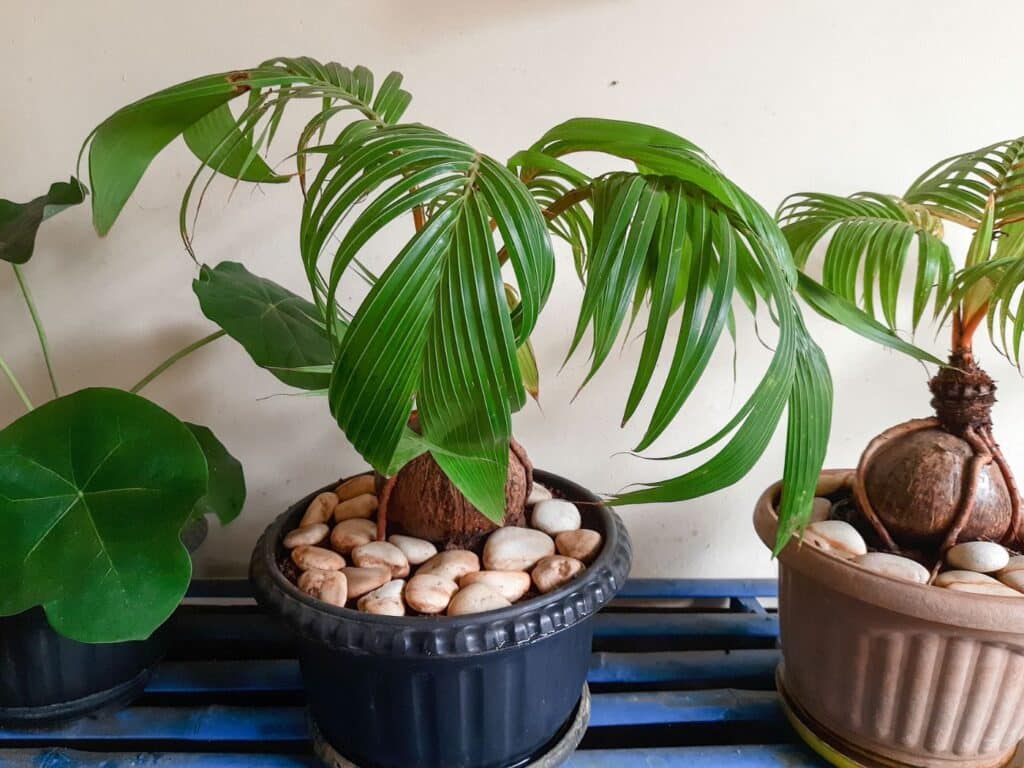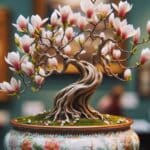Bonsai trees come in all shapes and sizes, and a huge variety of tree species can be used to grow these attractive miniature trees. You can bonsai a palm tree if your home or garden has a tropical feel.
Bonsai palm trees can be great for creating a summer or beach theme inside your home or in your garden. The plant species used for these types of bonsai are also elementary to maintain.
Let’s look at some of the best plant species to use to grow a striking bonsai palm tree and learn how to care for these types of ornamentals properly.
Can I Bonsai a Palm Tree?
It is essential to know that most of the ‘palm trees’ used for bonsai are not palm tree species. Most actual palm tree varieties like date palms, foxtail palms, queen palms, and king palms cannot be turned into bonsai. This is because these trees are naturally just too tall, and they don’t have any branches that can be wired or trained to create a miniaturized version of the tree.
Instead, other plants that look like palm trees, like sago palm trees or ponytail palm trees, are used to create palm trees even though these species are not palm tree varieties.
Some natural palm tree species, like coconut trees, parlor palm trees, and windmill palm trees, can be used for bonsai if kept in a small container and regularly groomed.

The Best Palm Tree Varieties for Bonsai
The number of varieties of trees that can be turned into a bonsai palm tree is limited, and even though they look like palm trees, the most common plants used for palm tree bonsai are not palm tree species at all.
Here is a quick look at some of the best plant species to create a cute tropical bonsai palm tree.
Sago Palm Tree Bonsai
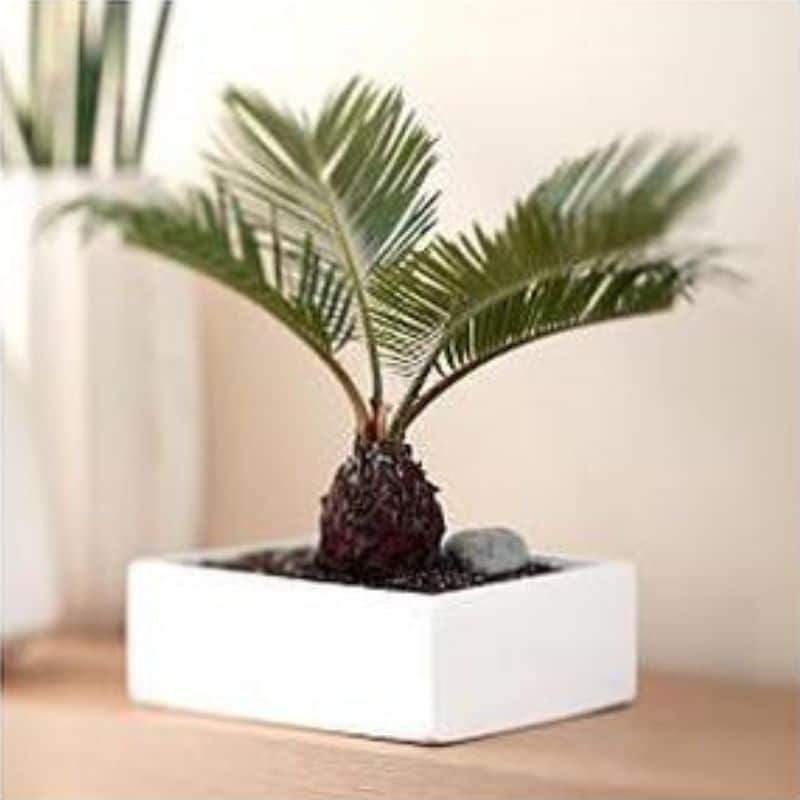
The sago palm tree (Cycas revoluta) has a palm tree appearance, but it is an angiosperm closely related to pine trees. These plants are also referred to as king sago palm and Japanese sago palm. This plant originates from the southern islands of Japan and is one of the most popular plant species for creating palm tree bonsai.
The plant produces a shaggy, thick trunk with exotic leaves resembling palm tree leaves. They are practical for bonsai beginners because the plant is straightforward to care for and is drought-tolerant and hardy. These plants also don’t produce any stems that can be trained.
These types of bonsai trees need to be grown from seed, and they are slow growers, so it will take quite a while before your bonsai appears mature. This slow growth rate can be slowed down even more by keeping the plant in a small pot so you can enjoy your bonsai for longer. Your sago bonsai palm tree can live up to 200 years with proper care.
Ponytail Bonsai Palm Tree
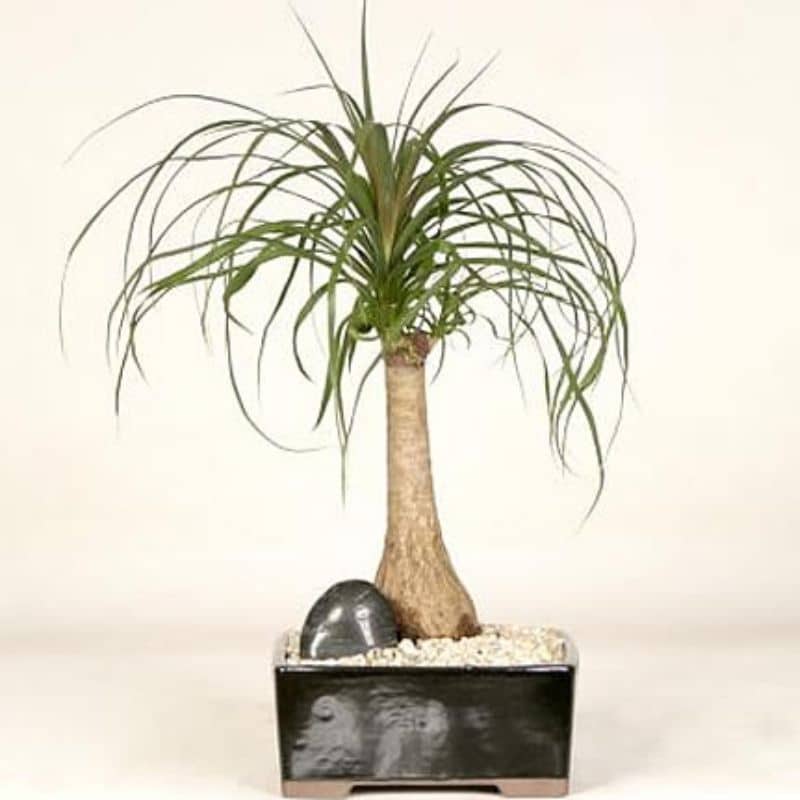
Ponytail palm bonsai (Beaucarnea recurvata) is a succulent family member and is native to southern Mexico. Ponytail palms are also known as bottle palms or elephant’s feet because they produce a thick bulbous trunk with airy foliage emerging from a slim stem.
This plant is ideal for bonsai beginners because it is remarkably tough. It stores moisture in the thick trunk and can survive up to four weeks without any water.
This plant species is easy to bonsai because its thick stem and airy leaves naturally give it a mature palm vibe. The slow-growing plant can be kept in dwarf form in a small container.
If the bonsai becomes too tall, it can easily be shortened by cutting off the tall stem. This will force the plant to sprout new stems, often resulting in multiple new stems that each produce a wavy ponytail foliage pattern. The multiple stems on the short, thick base will give your ponytail a thicker appearance with more lush foliage growth.
Your little ponytail bonsai palm tree can live 250 – 350 years with proper care, regular repotting, and the right conditions.
Coconut Bonsai Tree
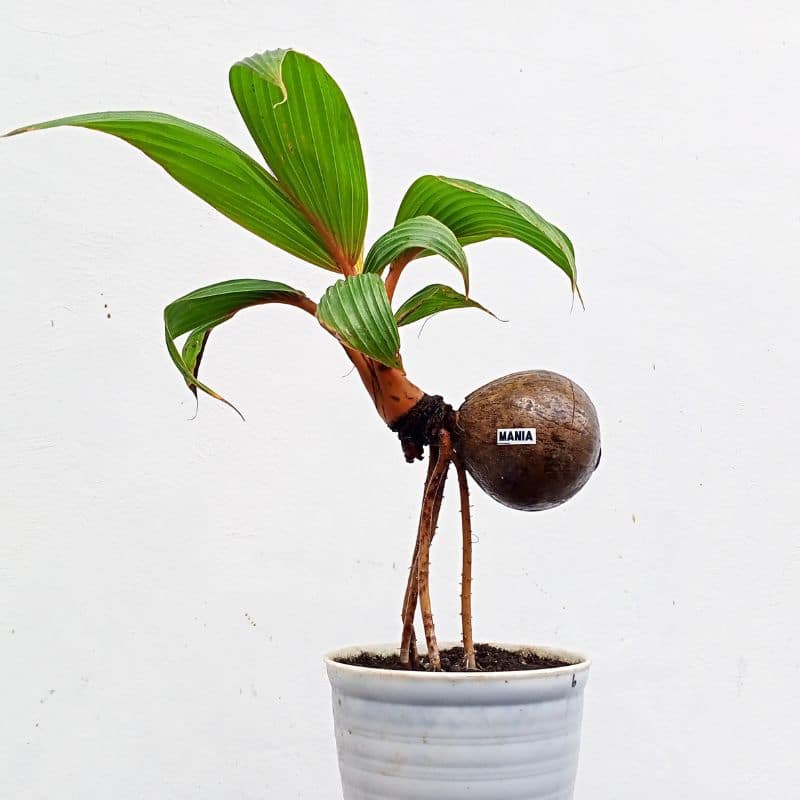
Coconut trees (Cocos nucifera) can grow up to 80 feet tall in their natural habitat. These trees are not the most common among bonsai enthusiasts, but you can successfully create them into a bonsai and keep them small for many years if you grow them from seed.
Most people prefer to keep the coconut seed as part of the bonsai palm tree because the seed gives the tree an exciting and bulbous appearance. Coconut trees naturally have a pretty thick stem and will look attractive even after the seed starts to erode, but you will need to keep your tree in a small container to keep it short.
Bonsai artists also need to constantly prune away large leaves because the foliage of this plant can become too big and may affect the appearance of your little tree.
Different from the previous two palm trees we mentioned on our list, this variety of plants doesn’t tolerate dry conditions too well. Coconut palm trees require lots of moisture and high humidity levels to flourish. They are more challenging to keep indoors since you will need a humidity tray to keep the tree content.
Windmill Palm Bonsai Tree
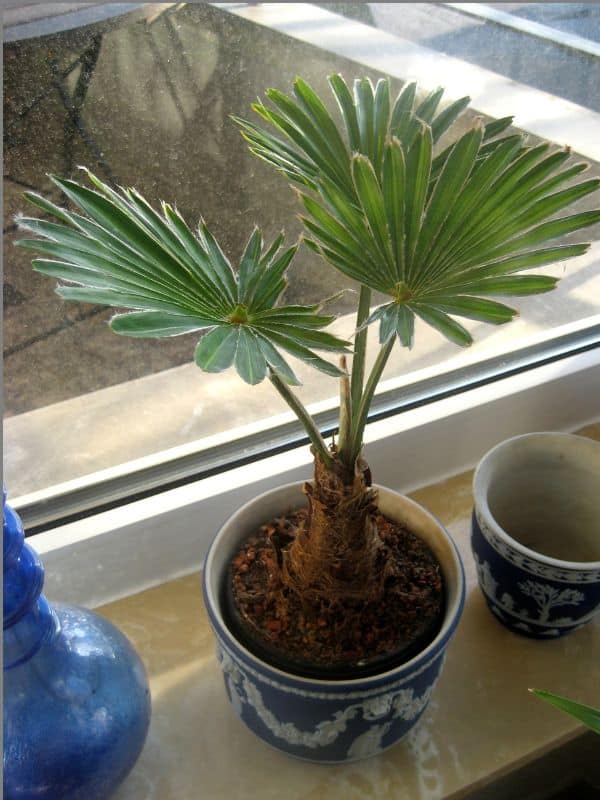
In natural environments, windmill palm trees (Trachycarpus fortune) can grow up to 40 feet tall and produce large, broad leaves. It is impossible to turn a giant windmill palm into a bonsai, but you can successfully create a miniaturized version of this plant if you grow it from seed or buy it as a sapling.
If this plant is placed in a small container and adequately maintained, it can stay small. Other strategies, like limiting direct sunlight, can also reduce the leaf size of the palm tree, and you will need to remove leaves whenever they become too large.
These plants naturally have a thick base with a wavy, lush leaf pattern and can look charming if you place them in a beautiful bonsai pot with some sandy topsoil to create a beach effect.
If you take good care of the small tree and ensure it receives the needed nutrients, it can stay alive for about 50 years.
Parlor Palm Bonsai
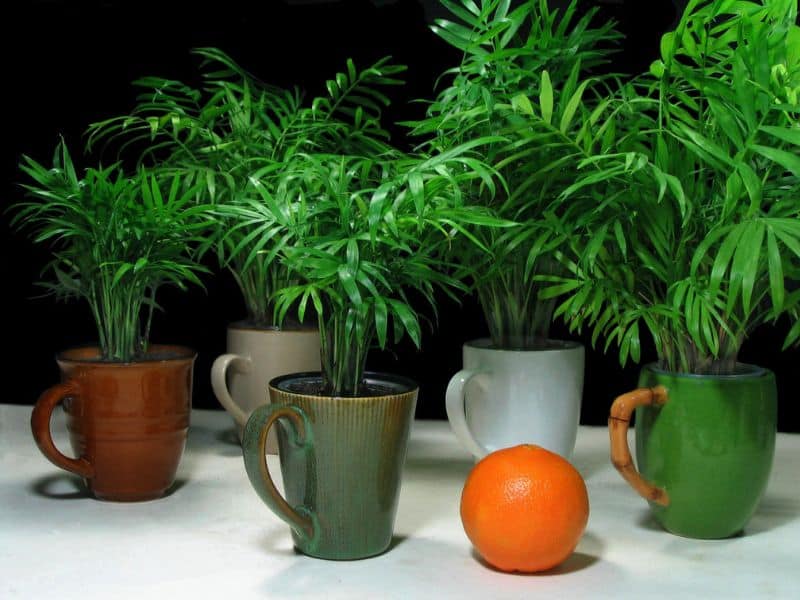
The parlor palm trees (Chamaedorea elegans) are a species of small palm tree that is native to the Southern Mexican rainforests. This palm is ideal for creating an indoor bonsai palm tree because it is often used and sold as a houseplant.
These palm trees can be kept small by trimming larger foliage and keeping the roots trimmed and contained in a small bonsai pot.
Most bonsai artists use this type of tree to create a rainforest effect by pairing several small palm trees in a pot. Grouping a couple of young plants will give the palm tree a more dense appearance, whereas a single stem might seem too empty and slim to make an attractive bonsai display.
These indoor bonsai palm trees typically only live a few decades or 20 years, but their vibrant lime-green foliage makes them worthwhile.
How to Grow a Bonsai Palm Tree
The tree species used for bonsai palm trees usually consist of a single thick base with leaves. Because they don’t produce any stems it can be difficult to style them and keep them small. If you want to grow a bonsai palm tree then it is always best to start it from seed or to work with a sampling.
Here is a quick look at how to grow these interesting bonsai plants.
Propagation
Palm trees cannot be propagated from cuttings. They need to be planted from seed or pup division. Let’s take a look at how to propagate your plants.
Propagation Through Pup-Division
Some palm tree species can be propagated by pup division. Varieties like ponytail palms, sago palms, and windmill palms will occasionally create “pups” or offshoots at the base of the tree. These offshoots are usually located close to the root system.
You can remove the small offshoots and place them in a container with potting soil. Keep the soil moist and position the pot in indirect light until new roots start to sprout.
Gradually decrease moisture so the new roots won’t rot. You can also gradually increase sunlight until your “pup” is nice and healthy.
Propagation from Seeds
If you are growing a palm tree from seed then you can follow the following start with a quality seed or coconut.
Soak the seed in water for a few days. Once softened, you can peel away the exterior skin to reveal the hard seed coat.
Plant the seed in moist but not buggy soil. It is best to lay the seed down sideways and to leave the top part of the seed exposed or it might not germinate.
The seed should germinate in about 3 – 9 months depending on the variety.
Soil
Bonsai trees are kept small by keeping their roots trimmed and by keeping them in a small container. Since the little tree will be deprived of space, you need to ensure that it receives plenty of nutrients.
It is important to use quality bonsai potting soil for your tree. The soil should be rich in organic matter and it should drain well.
Pruning & Styling
Palm trees do not grow branches. Pruning is only done to restrict the leaves and to keep them small. Controlling the size of the leaves is also helpful for restricting the plant’s growth. The best way to do this is by removing the leaves when they become overly large and to thin out the leaves so the plant doesn’t have too much foliage.
Repotting and Transplanting
Palm tree bonsai must be repotted every three years and re-established in a well-draining soil mixture. Palm varieties like coconut palms can be planted in soil that retains a bit more moisture because these varieties don’t like to be too dry.
When you remove the plant for repotting, you can trim away one-third of the old roots. This will encourage some new growth and will restrict some of its growth.
How to Care for a Bonsai Palm Tree
Once you have your little tree in a proper container, you will only need to ensure that it is well cared for. Here is a quick look at how to care for a bonsai palm tree.
Water
Bonsai palm tree species like sago palm and ponytail palm don’t need much water. They should be perfectly fine with weekly watering or less. Excess watering can lead to root rot with these plant species.
Varieties like coconut pine must be kept moist or they won’t grow well. These species should be watered about twice weekly to keep them in good shape.
Sunlight
All bonsai trees need direct sunlight in order to grow well. It is best to place your plants outside where they will get lots of direct sunlight. In indoor settings, your plant should be placed in a sunny window.
Temperature and Humidity
Ponytail palm bonsai can handle scorching temperatures and don’t need much humidity to survive. They are ideal for indoor palm bonsai since you won’t have to worry about them.
Other plants do however need more humidity. The coconut pine, for example, needs a humidity level of 75%. To raise the humidity levels of your indoor plants, you can position them in humidity trays or use a humidifier in indoor spaces.
All palm trees prefer warmer temperatures and can be brought indoors during the cold winter months.
Fertilizer
It is best to fertilize your bonsai plants throughout the year. You can use a liquid fertilizer and apply it a little bit once a month.
Pests and Diseases
These plants are not too vulnerable but you should look out for problems like rust, small insects, scale, or small bugs. These pests can easily be controlled with an organic insecticide.
Final Thoughts
Keeping a palm tree in a small bonsai form can be challenging, but these trees can provide lots of joy with their warm tropical vibe. They are also ideal for bonsai beginners since most varieties are easy to care for.
We hope that you enjoyed our guide and will have lots of fun growing and caring for your little bonsai palm tree.
Up next:

